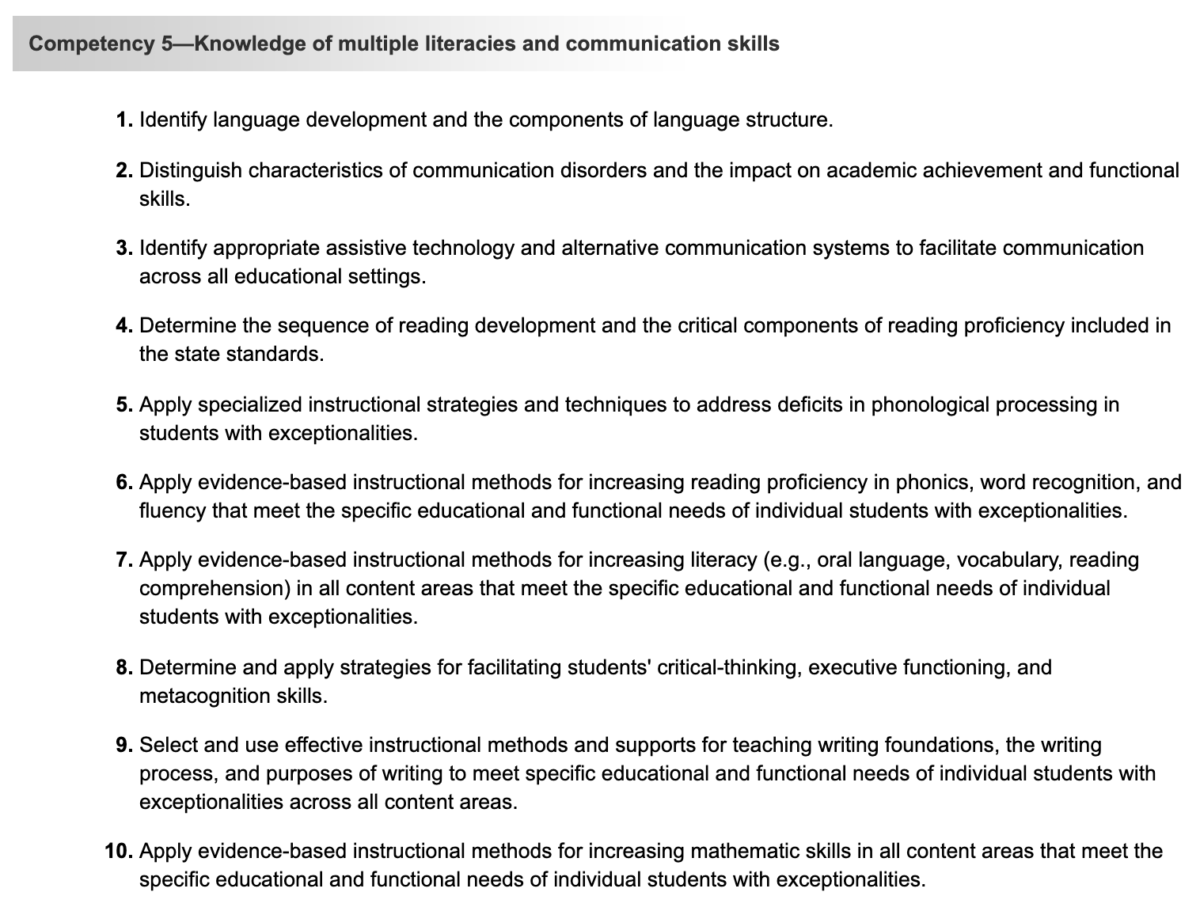FTCE Exceptional Student Education K-12 Competency 5: Multiple Literacies and Communication

The Multiple Literacies and Communication competency consists of about 26 questions and accounts for 22% of the test.
Keep reading to learn about a few important concepts.
Components of Language
Students may struggle with one or more of these areas of language competency.
Syntax
How words are used together to give meaning to a sentence
Example: “The girl quickly ran away” is different from ‘The girl ran away quickly”
Morphology
How words change by adding prefixes, suffixes, or plurals
Example: one mouse, two mice
Example: happy takes on the opposite meaning when given the prefix un- to form unhappy.
Phonology
How words sound within a language and the rules that create those sounds
Example: When two vowels are together in a word such as beat or roam, the first one makes a long sound and the second is silent.
Semantics
The meaning of words in a sentence independent of the larger context
Example: The word run can have a variety of meanings depending on the context. ”You have a run in your tights” is a different use of run
than “Don’t let your nose run”, which differs from “Let’s go for a run.”
Pragmatics
How words are used within the context of the situation
Example: The phrase “crack the window” means to open the window slightly if you just mentioned how warm it is indoors. If you are locked out of the house and say, “Crack the window,” it may mean to literally crack the window so that it breaks open.
Communication Disorders
There are many communication disorders; the most common are listed below. These often lead to social issues and the student being taught below their comprehension level, as they cannot adequately communicate that they understand what they are learning.
- Apraxia of Speech (AOS) – The inability to speak even though the words are ready in the brain. The student may be able to write or point to words to communicate, but they cannot verbalize them. This often leads to social issues and the student being taught below their comprehension level, as they cannot communicate that they understand what they are learning.
- Articulation disorder – This means the student has the words to say but cannot pronounce them correctly. Lisps, stuttering, and other difficulties are included in this category.
- Speech delay – A student is not making age-appropriate progress in either expressive speech or receptive speech. Expressive speech is the child’s ability to verbalize needs and wants. Receptive speech is the child’s ability to understand what is said to them and respond appropriately.
Language Experience Approach
The language experience approach takes all four language skills (speaking, listening, reading, and writing) into account when teaching literacy. It begins with an experience such as a field trip. Then a text is created by the class about the experience. The teacher then reads what has been written and the students revise the text. Finally, the text is read, usually as a group or as an echo exercise, depending on the abilities of the students.
For students with exceptionalities, this method is helpful, since they work as a group to develop a written piece. It ensures that they do not get stuck on one aspect of the exercise, and it uses personal experiences to develop skills.
Reading Development
There are five stages of reading development:
- Pre-emergent reader (6 months to 6 years) – The reader listens to others read stories, knows their letters, and asks questions about stories.
- Novice reader (6 to 7 years old) – The reader learns high-frequency or sight words and knows the sounds associated with letters. They can sound out one-syllable words and use pictures for word context.
- Decoding reader (7 to 9 years old) – The reader can use sight words and familiar story lines to determine the story and figure out words. Stories above their reading level should be read to them to continue to develop reading skills.
- Fluent, comprehending reader (9 to 15 years old) – Reading is used to learn, and new words can be determined using context. Comprehension increases, as do discussions about what is read.
- Expert reader (16 years and up) – The reader is able to comprehend complex texts and viewpoints. Comprehension is better when material is read than when presented verbally
And that is some basic information about competency 5 of the FTCE Exceptional Student Education K-12 exam.
